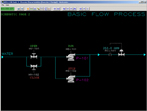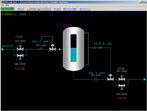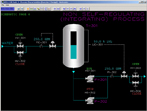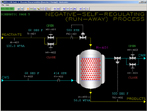
 |
 |
 |
 |
| Click to view schematic display A | Click to view schematic display B | Click to view schematic display C | Click to view schematic display D |
Process Description
The SPM-1100 Instrumentation I - Process Characteristics Process Simulation consists of four independent process loops. Each one of these process loops exhibits one of the four basic process characteristics seen in most typical chemical processing equipment.
The first process loop is the Basic Flow Process. This loop demonstrates the need for digital filtering (TD) for process response times faster than the controller sampling rate. In this process water is pumped from one location to another.
The second process loop is the Self-Regulating Process. This loop demonstrates a process with a natural tendency to move towards an equilibrium point. In this process water enters a hold-up tank and drains from the bottom by gravity.
The third process loop is the Non-Self-Regulating (Integrating) Process. This loop demonstrates a process with a natural tendency to move away from equilibrium in a linear fashion. In this process water enters a hold-up tank and is pumped out from the bottom.
The fourth process loop is the Negative-Self-Regulating (Run-Away) Process. This loop demonstrates a process with a natural tendency to move away from equilibrium exponentially. In this process Reactant A is catalytically converted to Product B in a jacketed single-bed fixed-bed exothermic reactor. The heat of reaction is removed by cooling water.
Instrumentation
In the Basic Flow Process, water flow is controlled by flow controller FIC-101. The block valves can be opened and closed with switches HV-101 and HV-102. The pumps can be started and stopped with switches HS-101 and HS-102.
In the Self-Regulating Process, water flow to the tank is controlled by flow controller FIC-201. The inlet block valves can be opened and closed with switches HV-201 and HV-202. Tank level is controlled by level controller LIC-201. The outlet flow is indicated by FI-202 and the outlet block valves can be opened and closed with switches HV-203 and HV-204.
In the Non-Self-Regulating (Integrating) Process, water flow to the tank is controlled by flow controller FIC-301. The inlet block valves can be opened and closed with switches HV-301 and HV-302. Tank level is controlled by level controller LIC-301. The pumps can be started and stopped with the switches HS-301 and HS-302. The outlet flow is indicated by FI-302 and the outlet block valves can be opened and closed with switches HV-303 and HV-304.
In the Negative-Self-Regulating (Run-Away) Process, Reactant A flow is controlled by flow controller FIC-401. Reactant inlet temperature is indicated by TI-401, reactant composition is indicated by AI-401, and reactant inlet block valves can be opened and closed with switches HV-401 and HV-402. Reactor outlet temperature is controlled by TIC-402. This controller controls the cooling water flow rate through the jacket which is indicated by FI-402. Cooling water inlet temperature is indicated by TI-403, and the cooling water block valves can be opened and closed with switches HV-403 and HV-404. Product composition is indicated by AI-402.